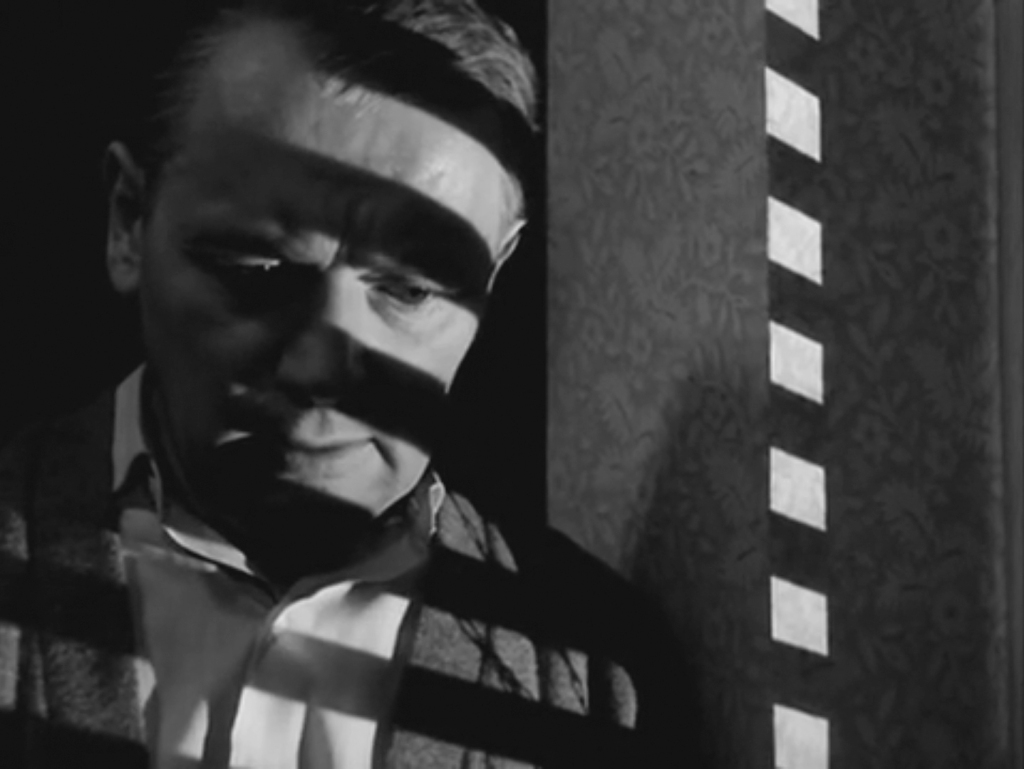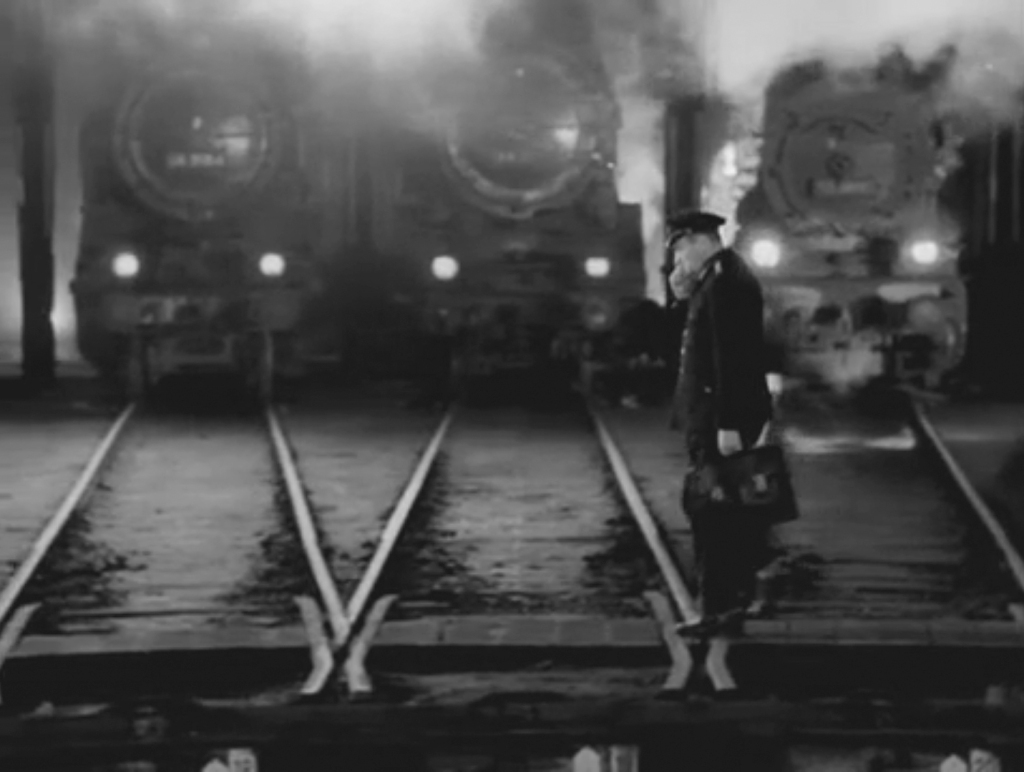Film noir is not a term that is usually associated with East German cinema. It is used most often when discussing the Warner Brothers crime films of the 1940s. Noir comes with certain rules that must be followed. The main ones are: characters whose complexity keeps them from falling into easily identifiable categories of good and evil; atmospheric use of shadows and unusual camera angles that serve as signifiers for the moral choices that the characters must struggle with; and usually—though not always—a crime or other tragic event. One of the best-known and most interesting examples of an East German film noir is The Second Track (Das zweite Gleis), directed by Joachim Kunert.
Based on a story by the director and the prolific German author, Günther Kunert, The Second Track starts with an incident in a trainyard in which yard inspector Walter Brock catches two men trying to steal goods from one of the boxcars. After one of the men is apprehended, Brock suddenly changes his tune and claims he can’t identify the man. The thief, a man named Erwin Runge, knows he has seen Brock before, but can’t remember where. He sends Frank, his young partner-in-crime, out to seduce Vera, the inspector’s daughter, in hopes of finding out just who Brock really is. The young thief gets emotionally involved with the daughter and the two of them go off to find out what happened to her mother. Pretty soon, all the dark secrets of the past come bubbling to the surface, for both Brock and Runge.

The Second Track was made in 1962 and released just a little over a year after the wall went up. Although it was seen by West Germans and Americans as a symbol of oppression (quite understandably), the wall also afforded new opportunities for creative freedom in the East German film community. The GDR was anxious to make a point that the wall was built to stop the west from trying to destroy the East German economy and morale. It was important to show that the wall had nothing to do with oppression, and to this end, many restrictions on filmmaking were eased. For the more imaginative directors, this was a time to stretch their wings. It was during this period that we saw Konrad Wolf’s Divided Heaven, which presaged the New German Cinema by several years. It was also when Gottfried Kolditz reintroduced the musical to East Germany with Midnight Revue and Beloved White Mouse. For Kunert and his cinematographer, Rolf Sohre, it was an opportunity to demonstrate what they could do when left to their own resources.
Like any good film noir, the characters are complex and hard to categorize. Frank is a thief, but he is also the person that seems the most interested in finding out the truth. Likewise, Walter Brock is basically a good man, but he has been lying to his daughter all her life in an attempt to hide his shameful past. Vera is the most innocent person in the story, but even here our introduction to her is from a colleague who describes her as a block of ice. Even the venal Erwin Runge becomes more complicated when his ex-wife explains that he was once a good man who was changed by the war.
The character truest to the film noir genre is Frank. Like Philip Raven—Alan Ladd’s character in This Gun for Hire—he is a man on the wrong side of the law, who, through his love for a woman, comes to do the right thing. The actor, Horst Jonischkan, was primarily a stage actor (as was Albert Hetterle, who played Brock). Jonischkan appeared in several DEFA productions, most notably, The Song of a Trumpeter (Das Lied vom Trompeter), in which he portrays a young trumpet player who dies for the cause (the cause being communism, of course).

Director Joachim Kunert got his start in films as an assistant-director at DEFA, where he worked for six years before directing Ein Strom fließt durch Deutschland (A River Runs Through Germany), a 30-minute color film about the Elbe River. His documentary short, Martin Andersen Nexø, about the Danish author of the same name, was banned in West Germany. It was during the early sixties that Kunert was able to really show what he could do with The Second Track and his next feature, the extremely popular film The Adventures of Werner Holt. After the 11th Plenum, things got a bit more difficult for him. While attempting to make a film from Franz Fühmann’s book on Hans and Sophie Scholl, Kunert ran afoul of the authorities and spent the rest of his career making movies for television. As a fan of the work of author Anna Seghers, he has made three films based on her novels (Die Toten bleiben jung, Die große Reise der Agathe Schweigert, and Das Schilfrohr), and a segment for another film (Das Duell segment in Aus unserer Zeit).
The cinematography for this film was by Rolf Sohre, and it is sensational. The dramatic shots of the trains pulling in and out of the yard and roundhouse are reminiscent of O. Winston Link’s moody railroad photographs. Many scenes in the film are bathed in light and shadows, including that reliable old noir trope: the striping of venetian blinds at night. Faces often are either hidden or partly obscured by darkness, echoing the dark secrets that hide in the pasts of the two older men.
Sohre grew up around cameras and film. His father was a projectionist and owned a movie theater for a time, while his uncle owned a photography studio in Dresden. As a young man, he worked for both men, learning everything everything there was to know the art of photography and the mechanics of movie equipment. In The Second Track, he pours his knowledge of these things into every frame. Although several scenes take place in darkened rooms, the shots are never muddy or obscure. Every frame of this film is as clear as crystal. Toward the end of the GDR’s existence, Sohre left DEFA and took up photography full time. He lives in Nuthetal, a small municipality southeast of Potsdam.

The music for the film is by the Slovakian composer, Pavol Simai. Simai composed the music for a solo harp, played by the East German classical harpist, Jutta Hoff. Simai explores the harp in every way imaginable, having Hoff strike, pluck and even scratch the strings. It is one of the strangest film scores from East Germany—a country already notable for some very odd film scores. Simai only composed music for a few movies before bowing out to continue his studies. In 1968, he moved to Sweden, where he took up residence in Göteborg. There he taught and composed pieces for orchestra and guitar. He is best known for his “Impressions for Guitar” as performed by Czech/Swedish guitarist, Josef Holecek. In 2001, a CD of his classical pieces was released under the title, “Key.” It is currently out of print.
During its existence, DEFA, and its television counterpart DFF (Deutscher Fernsehfunk), produced dozens of Krimis (crime films). Stories about criminals and spies were very popular, and many of the DFF Krimis are available in Germany in boxed sets. The quality of these films vary greatly. A few films from the GDR can rightfully be considered film noir, but none is more deserving of the title than this one.
I you like what I do here and would like to let me know, you can buy me a cup of coffee by clicking on the button to the left.
© Jim Morton and East German Cinema Blog, 2024. Unauthorized use and/or duplication of this material without express and written permission from this site’s author and/or owner is strictly prohibited. Excerpts and links may be used, provided that full and clear credit is given to Jim Morton and East German Cinema Blog with appropriate and specific direction to the original content.


